**This post contains affiliate links and the publisher may be compensated if you make a purchase after clicking on these links.**
In part 1 of this series we set the stage for why leasing is better than borrowing because the rent charge is simple interest while the finance charge on the loan is compound interest.
Now, let’s look at three cases: Great credit (3% APR), Good Credit (6% APR), and borderline Fair Credit (12% APR). Obviously these are simply a single point within what are three good size ranges, but this example is best because we’re doubling the APR each time. Here’s the deal, and we’ll compare both financing and leasing:
| Attribute | Loan | Lease |
| Vehicle Selling Price | $27,500 | $27,500 |
| Sales Tax Rate | 8% | 8% |
| Upfront Sales Tax Amount | $2,200 | $ – |
| Lease Acquisition Fee | $ – | $700 |
| Other Fees (Registration Fee, Dealer Doc Fee, etc.) | $300 | $300 |
| Amount Financed / Cap Cost | $30,000 | $28,500 |
| Residual Pct (of Selling Price) | N/A | 60% |
| Residual Value Amount | N/A | $16,500 |
| Term (months) | 72 | 36 |
| Total Lease Depreciation | N/A | $12,000 |
| Average Principal or Depreciation Payment/Month | $416.67 | $333.33 |
Now, let’s look at the impact of the 3%, 6%, and 12% APR (and equivalent money factor) on the actual monthly payment, the finance/rent charge, and the equity position after 36 months:
Leasing vs. Financing at 3%, 6%, and 12% Interest Rate
| Attribute | Loan – 3% APR | Lease – 0.00125 Money Factor | Loan – 6% APR | Lease – 0.00250 Money Factor | Loan – 12% APR | Lease – 0.00500 Money Factor |
| Monthly Payment | $455.81 | $420.75 | $497.19 | $481.50 | $586.51 | $603.00 |
| Total Finance/Rent Charge after 36 months | $2,082.87 | $2,025.00 | $4,241.75 | $4,050.00 | $8,772.43 | $8,100.00 |
| Total of Payments for First 36 Months | $16,409.17 | $15,147.00 | $17,898.72 | $17,334.00 | $21,114.21 | $21,708.00 |
| Outstanding Balance After 36 Months | $15,673.70 | $ – | $16,343.03 | $ – | $17,658.23 | $ – |
| Net Payments After 36 Months | $15,582.87 | $15,147.00 | $17,741.75 | $17,334.00 | $22,272.43 | $21,708.00 |
Notes about the table:
- The bolded figures represent the better deal for the consumer for the given credit profile.
- The “Net Payments After 36 Months” is the Total of Payments for First 36 Months + Outstanding Balance After 36 Months – $16,500, which was the residual value for the vehicle, so what we assume would be the trade-in value offered to a borrower.
-
- The monthly payment for the lease is higher than the loan at 12% interest because the Rent Charge is figured as Cap Cost + Residual Value, and a 60% Residual Value is high. So it won’t always be that way, but we’ll get to why even the higher monthly payment still favors leasing.
- As described in part 1 of this series, in a loan most of the total finance charge is front-loaded, so while the loan has twice the term of the lease, it always has more finance charge in that same timeframe because of compound interest.
- Still on line 2 – notice that the rent charge moves linearly – we double the money factor and the rent charge doubles. However, doubling the APR more than doubles the finance charge, widening the gap between finance charge and rent charge as the interest rate increases.
- In line 3, this is simply the monthly payment multiplied by 36, to show how much the consumer would pay after 36 months in each scenario. So whatever is best in line 1 is best in line 3.
- For line 4, obviously at the end of the lease nothing is owed (let’s assume you can negotiate away any purchase option or disposition fees because the dealer wants your business), but also recall that the loan was for $30,000. In all three cases, the loan balance is still over $15,000 – half the original loan – and yet you’ve made half the payments.
- Line 5 sums it all up: While you do get something out of your loan payments – equity in the car – remember that the car is depreciating, so most of the extra payment is simply paying for compound interest, and when you subtract out the equity in the car that you get with a loan and not with a lease, you still will have paid more.
- Final note about Line 5 – at the 12% rate the loan payment was less than the lease, but so much principal remains on the loan, because so much of those early payments are interest, that the consumer is upside down by over $1,100 after 36 months! Again, if the residual value was lower, the monthly payment for the lease may be lower than the loan too, and the consumer would be that much more upside down – because the loan balance would still be $17,658, but on a car worth even less!
Next Article: “Road Trip!”
Previous Article: “Leasing Vs. the Most Powerful Force in the Universe”

